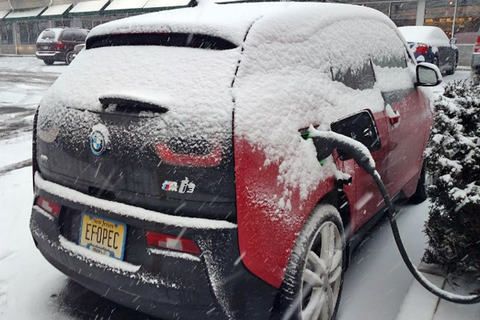Chaz Andrews, Technical Manager at Doepke UK considers the revised safety requirements for EV charging installations in the 18th Edition.

The 18th Edition Regulations for EV installations Section 722, includes several changes to improve design safety and performance. One of these changes (722.531.2.101) relates to the selection and use of Type A RCDs with 62196 sockets. Type A can only be used if “the installation incorporates a method of detecting DC residual currents > 6 mA which results in disconnection of the AC supply from the charge point".
Why has this revision been introduced?
The 17th Edition Regulations placed the responsibility on the Installer to verify the selection and suitability of the RCD for each installation, based on the amplitude of the DC residual current component related to the vehicle on charge. This value would be determined by reference to the EV Make and Model i.e. Amendment 3 722.531.2.101 stated that;
“…The RCD protecting the charging point shall be at least type A… If it is known that the DC component of the residual current exceeds 6 mA, then a type B RCD complying with BS EN 62423 shall be installed.”
The wording of the 17th Edition clause resulted in the widespread use of Type A RCDs in EV installations. The charging of vehicles, that produce dc residual currents > 6mA represents a safety hazard for the associated installations.
Meeting the revised Regulation 722.531.2.101 for RCD selection
The 18th Edition requires the provision of protective measures for DC fault currents for all installations using 62196 sockets; quote the appropriate measures shall be:
RCD Type B
or
Type A where the installation incorporates a method* of detecting DC residual currents, >6 mA which results in disconnection of the AC supply from the charge point.
Terminology
The terms “Detection” and “Monitoring” are used in the Regulations to differentiate between products that can detect residual currents and “Protection” products that are designed to provide protection i.e. an RCD - see 411.1 Note relating to RCMs and 722.531.2.101 relating to RCD design standards.
Methods for detecting 6 mA DC and disconnecting the supply
IEC 62955 specifies the requirements for equipment suitable for the monitoring and detection of DC residual currents in EV charging installations. These devices are collectively referred to as Residual Direct Current Detecting Devices (RDC-DD), not to be confused with an RCD!
See below for details of the various methods for detecting DC residual currents, proposed in IEC 62955. These should be kept in mind when reviewing specific EV charge point manufacturers products features + any additional product required to meet the revised installation requirements.
RDC-DDs must meet one of the formats detailed below and the associated disconnection times specified in the standard, for dc residual current values and non-operating time for AC values. This is to ensure compatibility when using a separate RDC-DD with an RCD.
RDC-M: Monitoring Devices, Units & Modules
The three formats proposed for RDC-Ms:
• With mechanical switching built into the unit
• Mechanically coupled to a switching unit (RCD, MCB)1
• Electrical output for operation of a control device 2
Note 1: If the associated switching device above, is not an RCD as defined in clause 722.531.2.101, a separate 30mA Type A or F RCCB, RCBO must be connected in series with RDC- M unit.
Note 2: For incorporation within the charge point by the OEM.
RDC-PD: Protection Devices
This is a combined format incorporating 6 mA DC detection and 30mA Type A protection in one unit. This unit can be easily installed or retrofitted in the field, to meet the revised installation requirements. The table below summarises the main differences between various formats proposed in the standard.
EV Charging Characteristics – Installation Design considerations
Specific EV models are designed to be charged from sockets protected by Type B RCDs. Under the revised standard, charge points containing Type A RCDs + 6 mA DC detection will prevent vehicles being charged if they produce 6 mA DC or more residual current.
Public charging facilities specification should take account of the need to provide Type B RCD protected charge points for specific vehicles. For commercial sites requiring charging facilities for fleet vehicles, check the EV Manufacturers specification, before quoting for the installation of charge points and associated electrical infrastructure.
DC residual current tripping characteristics

EV Charging Installations containing RCDs in series – Single charge point
 Where installation design/regulations require RCDs to be connected in series (531.3.2), the upstream RCD will be subjected to the same residual currents as the charge point RCD. Consequently, the upstream RCD Type must be selected, based on the total dc residual current produced under faultconditions.
Where installation design/regulations require RCDs to be connected in series (531.3.2), the upstream RCD will be subjected to the same residual currents as the charge point RCD. Consequently, the upstream RCD Type must be selected, based on the total dc residual current produced under faultconditions.
In figure 2, the supply feeds a single charge point incorporating 6 mA dc residual current detection. The upstream RCD will only be subjected to a dc residual current < 6 mA.
In this case, it is safe to install a Type A RCD as the upstream device i.e. Type A can be used with < 6 mA dc and still provide the required level of protection.
If a Type B RCD is installed in the EVCP, then the upstream RCD must be Type B – see Type B dc tripping characteristics above i.e. 15 <60 mA dc for 30 mA AC.
EV Charging Installations containing RCDs in series – Multiple charge points
In figure 3, the upstream RCD protecting the feeder cable, wi ll be subjected to the combined leakage currents of the downstream charge points and must be selected accordingly.
ll be subjected to the combined leakage currents of the downstream charge points and must be selected accordingly.
In figure 3, the supply feeds two charge points incorporating 6 mA dc residual current detection. The upstream RCD, protecting the feeder cable, will be subjected to the combined leakage currents of the downstream charge points and must be selected accordingly i.e. Type B
The other solution to consider which may be more cost-effective: Install two separate feeders as per fig 2 i.e. the cost of two separate Type A devices rated for the downstream load + additional space and wiring, compared to the cost of one Type B RCD rated for the total load on the feeder.
Where this is not possible, then Type B must be used for the main feeder RCD, to provide the level of protection required by the Regulations.
Transients / Nuisance Tripping
Certain EV models produce high transients on connectio n to the AC supply. This will trip a standard Type A device.
n to the AC supply. This will trip a standard Type A device.
Transient resistant RCDs, such as the Doepke AKV, will remove this problem, unless there is fault with the individual onboard EV charging circuit.
Note: Type AEV, F, Type B and Selective RCDs include transient resistant features as standard.
Specify and Install the correct RCDs
The levels of dc residual current, leakage currents and transient currents vary, based on the EV make and model. Local authorities and private companies offering public and or staff charging facilities have no control over the EVs that will be connected to their EV infrastructure and therefore need to cater for the worse case.
The revised Regulations represent current “state of the art”, for charge point safety. The liability associated with any accident resulting from the provision of unsafe equipment, or the use of equipment that is known to be unsafe, is clearly defined in the Electricity at Work Regulations for non-domestic installations. The risks associated with personal and installation safety, when using 13 Amp sockets for charging electric vehicles are well documented. This 18th Edition revision clarifies the application of Type A RCDs for Mode 3 charging installations. The associated Trade, UK Standards and Regulations Bodies, need to provide clarification on the installation requirements for RCDs used in conjunction with Mode 1 and 2 chargers.
To prevent death from electrocution, RCDs must operate before the residual current reaches a dangerous level and within the defined disconnection time, especially when individuals are in direct contact with the ground (outside). As EV charging equipment ages, there is an increased risk of faults developing due to general wear and tear, the quality of the original components used and the installation work. Regular maintenance and installation checks are a fundamental requirement to ensure continued safety for Users.

